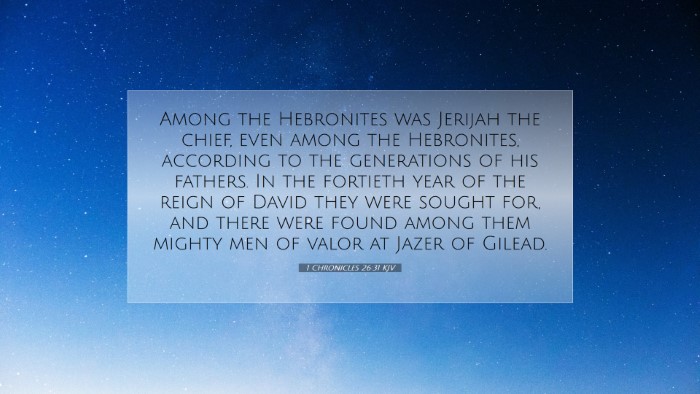1 Chronicles 26:31 - Commentary
Verse Reference: 1 Chronicles 26:31 (KJV) - "And of the Hebronites, Jeriah was the chief; even among the Hebronites, according to his generations, by the house of their fathers."
Overview of the Passage
This verse is part of a larger section detailing the organization of the Levites and their responsibilities in the Temple service. 1 Chronicles 26 focuses specifically on the porters and gatekeepers assigned to different positions of service, reflecting the careful structuring of the worship and administrative roles within the temple community.
Historical Context
The Hebronites are descendants of the tribe of Levi, stemming from the lineage of Korah, which is significant in the context of Hebrew worship and the priestly duties. Their mention highlights the importance of lineage and family in the Levitical priesthood.
Commentary Insights
Matthew Henry's Commentary
Henry emphasizes the significance of Jeriah’s chief position among the Hebronites, noting that leadership is derived from acknowledged merit and lineage. He comments on the honor attached to each family line and the responsibilities placed upon them, suggesting that the roles assigned within the temple were not merely administrative but integral to the spiritual life of Israel’s community.
Albert Barnes' Notes
Barnes expands on the genealogy and lineage of the Hebronites, asserting that Jeriah, being chief among them, represents the continuation of responsibility across generations. He reinforces the idea that God’s order within the temple is maintained through established families, promoting stability and continuity in worship and service to the community. This arrangement underscores the importance of heritage in God’s design for worship and leadership.
Adam Clarke's Commentary
Clarke offers a critical perspective on the role of Jeriah, noting the emphasis on the heads of families as a means of organization within the temple. He posits that the mention of generational lineage conveys God’s reminder of the enduring covenant with His people. Clarke also draws attention to the Hebronites' location and historical significance, suggesting that their choice as gatekeepers points to their strong, trustworthy reputation forged through years of faithful service.
Theological Reflections
The reference to Jeriah as chief among the Hebronites prompts a reflection on the nature of leadership in the church today. This biblical model illustrates that the positioning of leaders is often grounded in family and community trust, reminding contemporary leaders of the weight their roles carry in providing for and protecting the flock.
Covenantal Significance
The mention of the house of their fathers echoes the themes of covenant and inheritance throughout the Scriptures. Just as the Hebronites were chosen for specific temple roles, modern believers are called to recognize their place within the body of Christ, inheriting responsibilities that go beyond mere tradition to embody the mission of God in the world.
The Role of Generational Leadership
In examining Jeriah’s role, one can see an invitation to foster generational leadership within the church. As Hebronites were acknowledged for their legacy and service, today’s leaders must cultivate environments where future leaders can emerge from within their communities, ensuring the continuity and vitality of faith practices.
Practical Applications
- Valuing Heritage: Understanding the significance of one’s heritage in the context of faith can strengthen connections within church communities, encouraging respect for the traditions that shape their worship.
- Leadership Development: Leaders in faith communities should prioritize mentorship, recognizing the importance of nurturing the next generation in understanding their roles within the church.
- Community Responsibility: Just as the Hebronites were entrusted with guarding the temple, today’s believers are called to protect the sanctity of worship and the integrity of their communities.
- Emphasizing Covenant: Believers must be reminded of their status within God’s covenant family, encouraging a collective identity that promotes unity and purpose among the people of God.
Conclusion
The passage of 1 Chronicles 26:31, while detailing a historical organizational structure, provides rich insights relevant to contemporary worship and community life. The reflections on leadership, heritage, and communal responsibilities serve to encourage both personal and collective responses from today’s church. As we consider the example of Jeriah and his lineage, may we seek to embody the principles of faithful service and covenant commitment in all aspects of our lives.


